Synchronization between OCS servers master/slaves
Operating principe
You can use the OCS_OPT_GENERATE_OCS_FILES server parameter to automatically generate these files to "inject" it to a higher level server. (in case of multi entities configuration for example).
In that case, you can use a cronjob if the two servers are connected, or put it on the higher level server and run it on loopback.
Warning: This feature just allows you to "inject" inventories into a higher level server. It will be
impossible to deploy packages from the highest server.
Simplified Diagram

Prerequires
ocsinventory-injector.pl is a script designed to send inventory to an OCS server using .ocs files generated by -local (or /XML for windows). You must have a writable directory to store .ocs files. If you want to automate this synchronization, you have to create a cronjob.
please note, as of the December 2020 and the release of the 2.8.1, the perl injector will have its powershell counterpart in order to be able to inject from a windows machine.
Perl injector and powershell injector can be found in the binutls directory of the release.
Configuration of management console

To configure this feature, click on Config, and Config. Then, click on Inventory Files tab.

Warning: Don't forget to create the directory with writable rights.
Server configuration
The configuration file is in
/etc/apache2/conf.d/z-ocsinventory-server.conf
You can verify values here
# ===== INVENTORY FILES MAPPING SETTINGS =====
# Use with ocsinventory-injector, enable the multi entities feature
PerlSetEnv OCS_OPT_GENERATE_OCS_FILES 1
# Generate either compressed file or clear XML text
PerlSetEnv OCS_OPT_OCS_FILES_FORMAT OCS
# Specify if you want to keep trace of all inventory between to synchronisation with the higher level server
PerlSetEnv OCS_OPT_OCS_FILES_OVERWRITE 0
# Path to ocs files directory (must be writeable)
PerlSetEnv OCS_OPT_OCS_FILES_PATH /home/ocs
Warning: Values in database (GUI) take precedence over the configuration file, that's why you
have to use web interface to configure this feature.
Command line options
| Options | Complete options | Meaning |
|---|---|---|
| -h | --help | Command line options |
| -d | --directory | Load every .ocs files from a directory |
| -f | --file | Load a speficic file |
| -u | --url | Ocsinventory backend URL, default is http://ocsinventory-ng/ocsinventory |
| --useragent | HTTP user agent, default is OCS-NG_LOCAL_PL_v".VERSION." | |
| -r | --remov | Remove succesfuly injected files |
| -m | --msg | Show message returned my ocsinventory |
| -v | --verbose | Verbose mode |
| --stdin | Read data from STDIN | |
| --sslmode | Enable or disable SSL (0 | |
| --cafile | CA File to use for SSL Communication |
Note: You can specify a --file or a --directory or STDIN. Current directory is the default
Examples
Synchronsation of one inventory
perl ocsinventory-injector.pl -v -f myInventory.ocs -u http://OCSmasterServer/ocsinventory
Synchronsation of all inventories in a specific directory
perl ocsinventory-injector.pl -v -r -d /my/specific/directory -u http://OCSmasterServer/ocsinventory
Synchronsation of one inventory using HTTPS
perl ocsinventory-injector.pl -f MYFILE.OCS -u https://OCSmasterServer/ocsinventory -v --sslmode 1 --cafile /path/to/ca/file
Cron job
You can "inject" inventories automaticaly with a new entry in your crontab:
##### Every 5 minutes ----- execution of OCS injector
*/5 * * * * root perl /usr/src/OCSNG_UNIX_SERVER-1.3.3/binutils/ocsinventory-injector.pl -v -r -d /home/ocs -u http://OCSmasterServer/ocsinventory